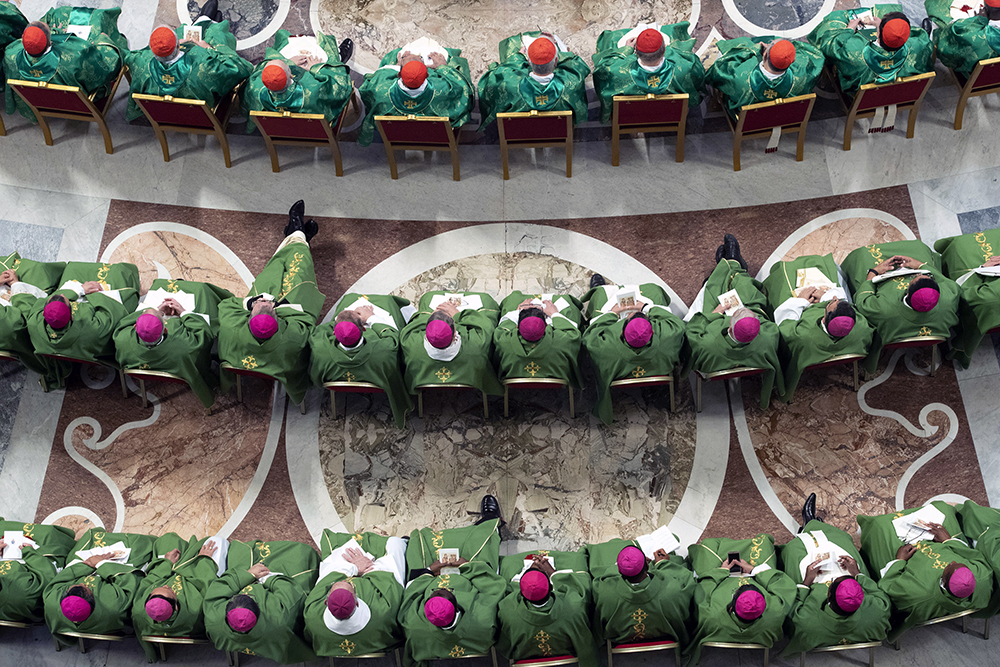[ad_1]
VATICAN CITY (RNS) – In Pope Francis’ vision for the future of the Catholic Church, the bishops will no longer make decisions alone but in dialogue and discernment with the faithful of their community. The new, expanded two-year process to prepare for synods will begin in October and promises to overthrow power structures in the church. When it comes to the voice of women in the church, however, that might not be enough.
The question of the role of women in the leadership of the Church remains one of the greatest ecclesial and social challenges of the Catholic Church. Despite Pope Francis’ appointment of women to leadership positions in the Vatican, women are not allowed to vote in synods – the summit of bishops in the Vatican – and cannot be ordained.
“The problem is that today most people still have the mentality of the church as a hierarchy. No! This is not the reality of the church! said Sr. Nathalie Becquart, who became the first female undersecretary of the Synod of Bishops when Pope Francis appointed her in 2021.
With the upcoming summit of bishops, “For a Synodal Church: Communion, Participation and Mission,†which will begin on October 10 and end when the bishops meet in Rome in October 2023, the focus will be on disrupting this hierarchy. history and establishing a new system, “where all the baptized are part of the mission of the church,” Becquart said.
Synodality – or Francis’ vision of how to approach synods – is a touchstone for understanding his plans for reforming the Catholic Church, but its meaning and application has been left open to interpretation. “It is not easy to explain what synodality is,” Becquart told Religion News Service at the Synod offices, a stone’s throw from the Vatican, on September 12. “You find out through experience.”
To this end, images are Becquart’s preferred medium for conveying the meaning of synodality. She cited several examples, from the biblical passage from the journey to Emmaus, where the Risen Christ was walking with two disciples, to the Tent of Meeting in Exodus. Some, she said, have described synodality as “dancing together” while “listening to the music of the Holy Spirit.”
The images attempt to convey a compelling model of decision-making, where all the Catholic faithful come together at the local level to discuss, debate and dialogue about the leadership of the church. What should emerge is a clearer understanding of the “sensus fidelium,†or “sense of the faithful,†a fleeting concept intended to confer authority on the basis of universal consensus of believers.
RELATED: Women Are Essential in the Bible. Now they are in the Sunday readings
The sensus fidelium, however, is always linked to the conduct of priests, bishops and even the pope, who are responsible for keeping and preserving doctrine. Decisions will be made differently, but that doesn’t mean “getting rid of hierarchical principles,†Becquart said. “Synodality is not a parliament†subject to majority and minority dynamics, she stressed, but “thanks to mutual listening, we will find a consensusâ€.
FILE – In this file photo from February 10, 2021, Sister Natalie Becquart poses for a photo during an interview with The Associated Press in Rome. Pope Francis will launch a two-year consultation process with ordinary faithful next month aimed at revitalizing the Catholic Church. Becquart’s appointment earlier this year as undersecretary to the Vatican synod office had signaled that she at least would likely be able to vote, since her male predecessors had that right by the nature of their office. (AP Photo / Alessandra Tarantino, file)
Ultimately, however, an all-male clergy will have the responsibility of representing the concerns and issues of their laity at the bishops’ conference and eventually in the Vatican.
Becquart, who may be the only woman eligible to vote at the synod of bishops, said she believed women would feel like part of the synodal church’s decision-making process through synodality.
But being part of the discussion may not be enough for a new generation of women who want to be on par with men in the Catholic Church. Without a promise to compel male clergy to heed the feelings of the faithful, especially women, synodality risks being just a well-meaning conversation that can just as easily be dismissed.
“Will the conversation ever end?” Phyllis Zagano, an American Catholic scholar who advocates for the advancement of women in the church, said in a September 10 webinar on synodality and women. The effectiveness of synodality “will depend on each bishop,” she added, highlighting the disparate responses to the synodal process in several dioceses, particularly in the United States.
“As Western culture increasingly accepts women in positions of authority, the church doesn’t seem to be,†Zagano said. Clericalism, the belief of the clergy and the faithful that those who are ordained have more authority, is “on the verge of derailing the whole process if the voice of the people is not heard through official channels.”
Of course, unofficial channels for women’s voices to be heard have always existed in the church, through religious and secular movements and organizations, she added.
Today, expecting women to participate in decision-making is “part of the DNA of the people,” said Ethna Regan, professor of theology and philosophy at the University of Dublin, in an interview. with RNS.
According to the theologian, the synod on synodality is an opportunity for the Church “to really do something new in terms of consultation, and if they don’t seize this moment, they have no faith in the Holy Spirit!
“Either you believe that the Holy Spirit works through God’s people and that we can learn from each other, or you don’t. It’s that simple, â€she said.
RELATED: Pope Francis Takes Communion Ban: “I Never Denied Anyone Eucharist!
[ad_2]

